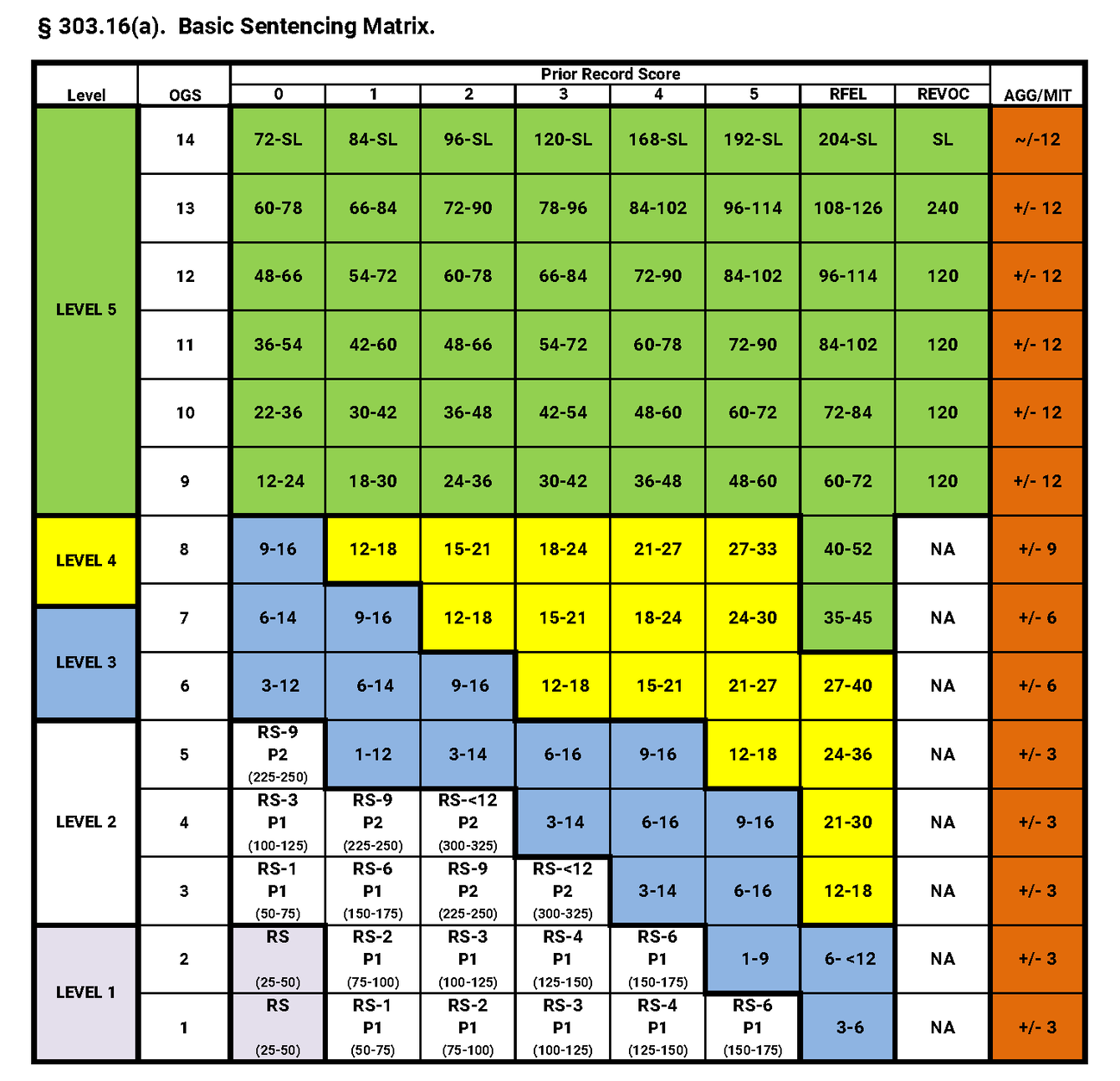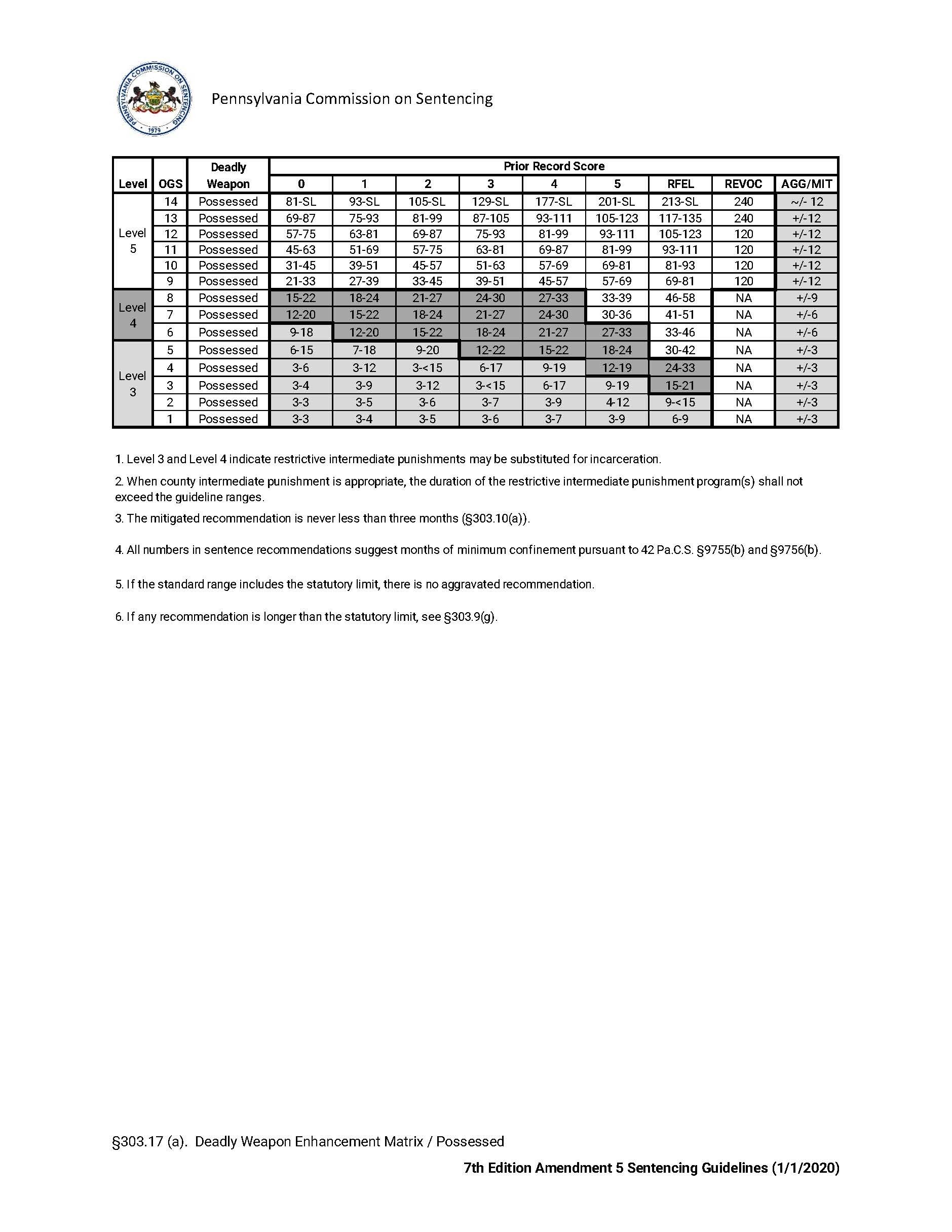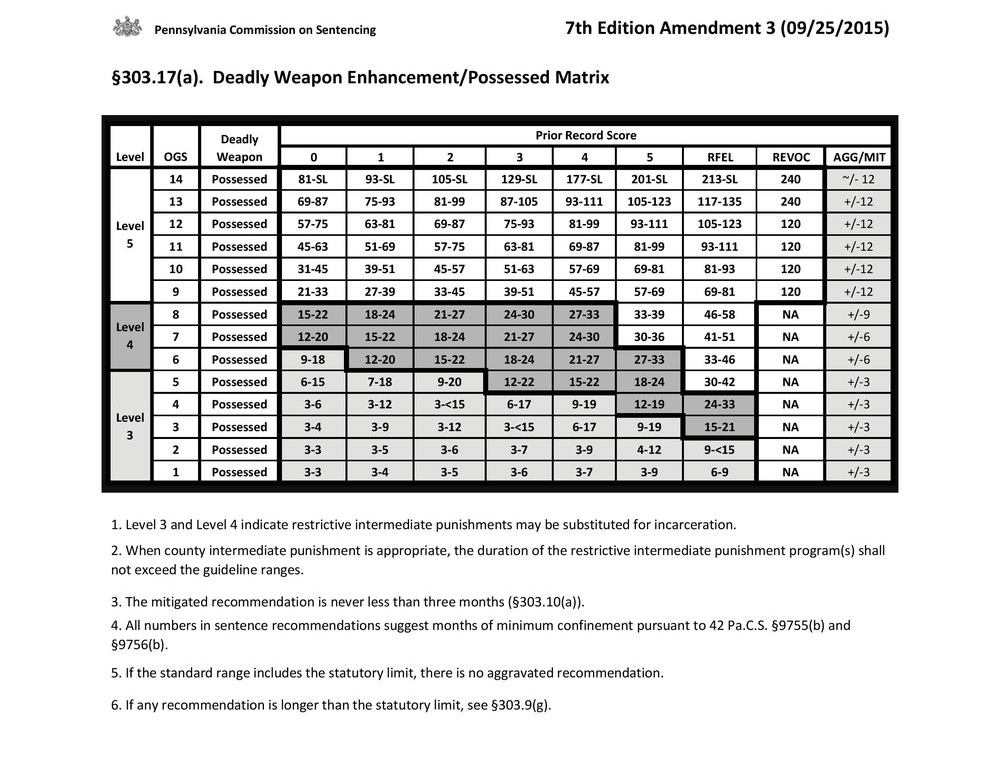
Philadelphia Criminal Defense Blog
PA Sentencing Guidelines | I got arrested. Am I going to jail?
The PA Sentencing Guidelines provide the sentencing judge with a range of minimum sentences to consider imposing following a conviction.
The Pennsylvania Sentencing Guidelines
Note: This article is based on the pre-January 1, 2024 guidelines. Any offense committed prior to January 1, 2024 will involve the guidelines discussed in this article. For a discussion of the new guidelines, please see this article.
One of the most common questions we get when meeting with a new client is, “What am I looking at if we lose? Am I going to go to jail?” The answer is almost always, “it depends.”
First, if the client has made the smart decision and hired one of our PA criminal defense attorneys, the client could very well be looking at winning the case or negotiating entry into a pre-trial diversionary program that will not result in a conviction or incarceration. The above question assumes that the client is going to lose and be convicted of the most serious charge, which is often not the case. There are many cases that can be won at preliminary hearing, through pre-trial motions, or at trial. Each case is different, but we regularly try and win cases. Even those cases that cannot be won can often be negotiated down to lesser charges, so even when the prosecution's evidence is strong, there is always the possibility of working out a good deal for the defendant. Therefore, there are lots of cases in which the client will ultimately not end up serving any kind of sentence or will eventually face a sentence on a less serious charge.
Second, although there are never any guarantees, it is usually possible to predict the best and worst case scenario by considering any applicable mandatory minimums, sentencing guidelines, and the sentencing practices of the judge. Even though it is never possible to predict an outcome or whether a defendant could go to jail with complete certainty, it is generally possible to have an idea of what the possible and most likely outcomes are for different types of charges.
Pennsylvania Mandatory Minimum Sentencing Laws
When considering what sentence you could get, the first place to start is to find out whether there are any mandatory minimums. Most Pennsylvania mandatory minimum sentences were eliminated by decisions of the United States and Pennsylvania Supreme Courts. However, a handful of mandatory minimums remain.
For example, there are still mandatory minimums for repeat offenders who are convicted of certain crimes of violence such as F1 Robbery, Aggravated Assault, Homicide, certain types of Burglary and Sex Crimes, and other serious “strike” crimes. There are also significant mandatory minimum sentences for DUI/DWI. Other mandatory minimums which apply to the sexual abuse or physical assault of children have also been reinstated and may call for significant periods of incarceration.
The Pennsylvania state legislature has considered reinstating the other mandatory minimums which were struck down by the courts such as those based on drug weights and gun possession while committing a crime of violence, but it has not yet done so. You can learn more about mandatory sentences here. There are also still a number of significant mandatory minimums for many federal charges. Therefore, the first step is to figure out if there are any mandatory minimums. If there is one, then the strategy will likely become avoiding a conviction for the charge or fact that would trigger the mandatory minimum. Any mandatory minimum will trump the sentencing guidelines, meaning that if the mandatory minimum is higher than the guideline range, the court must still sentence to the longer sentence called for by the mandatory minimum.
Calculating the Sentencing Guidelines in Pennsylvania
Second, once you and your defense attorney have determined whether there are any mandatory minimums which could apply to the offense, it is critical to calculate the Pennsylvania sentencing guidelines. The guidelines provide a good estimate of what type of sentence the defendant could receive if convicted. In both Pennsylvania and the federal system, the sentencing guidelines are not mandatory, meaning a judge can depart upward or downward from the guidelines if there is a good reason to do so. However, judges in both systems are required to correctly calculate the guidelines, strongly consider them, and provide sufficient reasons on the record for departing from them if they choose to do so. Departures from the guidelines are generally more common in state court than they are in federal court, but even in state court, the judges typically sentence based on the guidelines. In recent years, the guidelines have become less important in Philadelphia, but the judges must still calculate them accurately and consider them.
Under the Pennsylvania system, every sentence (except for extremely short sentences of a month or two) must have a minimum and a maximum. The maximum must always be at least double the minimum. If the maximum is two years or more, then the defendant will typically serve the sentence in a state prison. If the maximum is less than two years, then the defendant will serve the sentence in the county prison. There are some exceptions to this general rule for sentences under five years, particularly in cases involving Driving under the Influence. In those cases, the Commonwealth may agree to allow a defendant to serve even a two-year sentence in the county jail so long as the maximum is no greater than five years.
The Pennsylvania sentencing guidelines provide a recommended range for the minimum sentence. Once the judge picks a minimum, the judge is free to pick whatever maximum the judge feels is appropriate up to the statutory maximum for the offense. The recommended minimum range is calculated by determining the defendant’s Prior Record Score and the Offense Gravity Score of the charge. The Prior Record Score and Offense Gravity Score are then entered into a sentencing matrix, and the matrix provides a recommended minimum sentence. In many cases, the standard sentencing matrix will apply. However, if the prosecution can prove that the defendant possessed or used a deadly weapon during the commission of the crime, then an alternative matrix could apply which will recommend a more severe sentence.
The Offense Gravity Score
Each offense has an assigned numeric Offense Gravity Score. When the judge or pre-sentence investigator calculates the guidelines after a conviction or plea,they will do it for each offense. The judge will typically sentence based on the most serious charge, but a judge can always run sentences consecutively if the judge so chooses. It is often common to attach probation sentences to some of the less serious charges. For purposes of providing an example, possessing a concealed, loaded firearm without a license (which violates VUFA § 6106) carries an Offense Gravity Score of 9. The Offense Gravity Score for each offense can be found at http://www.pacode.com/secure/data/204/chapter303/s303.15.html.
Calculating the Prior Record Score
Once the Offense Gravity Score has been calculated, the next step is to determine the defendant’s Prior Record Score. Just as each charge has a corresponding Offense Gravity Score, each conviction also has a corresponding Prior Record Score. For example, Possession with the Intent to Deliver adds two points towards a defendant’s Prior Record Score. The Prior Record Score is calculated by adding up the points that correspond with each of the defendant’s prior convictions. The maximum Prior Record Score is 5, but there are two special categories for defendants with certain felony convictions. Defendants with prior convictions for F1 or F2 felonies which total more than 5 points have a prior record score of REFEL, and defendants with prior violent convictions for certain F1 felonies who are charged with additional violent offenses could have a prior record score of REVOC. It is also important to note that many adjudications of delinquency for juvenile offenders will count towards the Prior Record Score, but some will not. Many people mistakenly believe that juvenile records do not count in adult court, but depending on the offense and the defendant’s age at the time of the offense, the juvenile record may count towards the Prior Record Score. Even if it does not formally count, a judge will often be made aware of the conviction and will be free to consider it in deciding on as sentence. The Prior Record Score points for each offense are listed at http://www.pacode.com/secure/data/204/chapter303/s303.15.html.
The PA Sentencing Guidelines Matrix (Basic)
The Pennsylvania Sentencing Guidelines Matrix (Standard Range)
Sentencing Guidelines for Possessing a Concealed Firearm Without a License to Carry
Once the Offense Gravity Score and Prior Record Score have been calculated, the above sentencing matrix or chart can be used to determine the recommended minimum sentencing range. There are different matrices for crimes committed while in possession of a deadly weapon or where a deadly weapon was used, and there are also certain sentencing enhancements for certain offenses like possession of child pornography. However, the basic sentencing matrix above applies to most cases. As you can see, in the example above in which a defendant has a Prior Record Score of 2 for a PWID conviction and an Offense Gravity Score of 9 for a VUFA § 6106 charge, the recommended minimum sentence is 24 – 36 months plus or minus 12 months. This means a standard guideline sentence would have a minimum of somewhere between two and three years, but the judge can subtract 12 months if there is strong mitigation evidence or add 12 months if there are significant aggravating factors. The judge would then have to pick a maximum sentence which is at least double the minimum, so if the judge were to sentence the defendant to a minimum of 18 months of incarceration, the judge would have to make the sentence at least 18-36 months.
This leads to the last and possibly most important part of predicting what the defendant is looking at. As the example above illustrates, the judge has a tremendous amount of discretion in determining the sentence. For a VUFA 6106 conviction for a defendant with no record, which is an extremely common situation, the judge could sentence anywhere from probation to 3-6 years in state prison and still have imposed a guideline sentence.
It is very difficult to challenge a guideline sentence on appeal. The Superior Court is often reluctant to even review an above-guideline sentence. For this reason, it is extremely important to have a lawyer who understands not only the mandatory minimums and the applicable sentencing guidelines, but also the sentencing practices of the judge. If the lawyer knows from experience that the judge is likely to impose a mitigated sentence for an open (meaning non-negotiated) guilty plea, then the lawyer can advise a client to reject an offer from the Commonwealth which is not fully mitigated. Likewise, if the lawyer knows that the judge is likely to impose a low guideline sentence even after conviction at a bench trial, the lawyer may be able to provide advice that it is better to have a judge trial than a jury trial. Obviously, it is critically important that you hire a lawyer who knows the system, knows the law around sentencing, and has experience practicing before the judges who would ultimately impose sentence. It is even more important that you have a lawyer who understands the importance of sentencing and how to craft a persuasive mitigation argument for the judge in order to get the judge to impose a mitigated or below guideline sentence.
What factors does a judge consider at sentencing?
There are a number of different factors that a judge could consider at sentencing. For example, the judge will typically look at some of the following factors:
the seriousness of the offense,
whether the defendant has a prior criminal record,
whether the defendant has complied with the conditions of pre-trial release or participated in programs while in custody awaiting sentencing,
whether the defendant has a job,
and whether the defendant has community support and people who are willing to speak on his or her behalf.
A judge would also be required to consider any potential mandatory minimum sentence that could apply.
In order to obtain the best possible sentence for our clients, we often focus on obtaining proof of employment, character letters from friends, family, and community members, and proof of drug or alcohol treatment or other counseling as necessary. In some cases, it can be helpful to obtain an evaluation from a medical profession in order to prepare an expert report as to whether a defendant is likely to respond well to treatment.
Our Philadelphia Criminal Lawyers Can Help
Philadelphia Criminal Defense Attorneys
The Philadelphia Criminal Defense Lawyers of Goldstein Mehta LLC have the legal expertise and practical experience necessarily to properly advise and defend anyone facing criminal charges in Philadelphia and the surrounding counties. We know the law, we know the defenses, and we have experience practicing before the judges. We can evaluate your case and potential defenses and come up with a plan to minimize the consequences of an arrest – whether that means negotiating a better sentence or taking the case to trial for an acquittal. If you or a loved one are facing criminal charges, call 267-225-2545 today for a free, confidential consultation.
PA Sentencing Matrix (Deadly Weapon Possessed)
The Pennsylvania Deadly Weapon Possessed Guideline Matrix
PA Sentencing Matrix (Deadly Weapon Used)
The Pennsylvania Deadly Weapon Used Guideline Matrix
PA Superior Court Limits Deadly Weapon Used Sentencing Enhancement in Burglary Cases
The Deadly Weapon Used Enhancement does not apply unless the defendant used the deadly weapon while entering the building during a Burglary.
The Pennsylvania Superior Court has just decided the case of Commonwealth v. Tavarez. This decision limits the “Deadly Weapon Enhancement” for individuals convicted of burglary when a deadly weapon is involved. It requires that a sentencing court determine whether a deadly weapon was used in the commission of the burglary or whether a defendant merely possessed the deadly weapon at the time the defendant entered the building or occupied structure.
Commonwealth v. Tavarez
In Tavarez, the defendant pleaded guilty to one count each of aggravated assault, burglary, robbery, impersonating a public servant, and conspiracy. As part of his guilty plea, Mr. Tavarez stipulated to the following factual summary:
[O]n or about November 17th, 2015, shortly after 1:00 in the morning at 49 Mill Road in Oley Township, Berks County, Pennsylvania, you along with your accomplices and co-conspirators Edward Martinez, Brandon Smith, and Erick Green went to that residence; the plan even before - you arrived at the residence was to rob the people there; you believed that there were illegal drugs and money[] there to be gained; all four of you agreed to do that. When you got there, as was your intention all along, you and Edward Martinez entered the residence, there were people present. This was a residence. It was not open to the public at that time. You had no license or privilege to be there.
Once inside, you were yelling, [“]Police. Freeze[.”] in [an] attempt to compel the homeowners to do what you wanted them to do, thereby impersonating a public servant. Although you attempted to commit a robbery and you did so with firearms, nothing was actually taken.
When you confronted the homeowner, Eric Wegman, in the upstairs bedroom, he pulled his own handgun and fired, hitting both you and Mr. Martinez. Eric Wegman was also shot in the leg at that point.
Based on these facts, the trial court sentenced Mr. Tavarez to a 10 ½ to 30 years. The trial court did this, in part, by applying the “Deadly Weapon Used” enhancement to all of the charges, including the burglary charge. After he was sentenced, Mr. Tavarez filed a timely appeal. One of the issues Mr. Tavarez raised on appeal was whether the trial court erred in applying the “Deadly Weapon Used” enhancement to his burglary conviction.
What are the Sentencing Guidelines?
In Pennsylvania, an individual’s sentence will usually be determined by where the person falls on the sentencing matrix. The purpose of the sentencing matrix is to provide consistency in sentencing across the state. It is important to note that judges are not required to follow the guidelines and are free to depart from them when they see fit.
The first step in determining where a defendant falls on the sentencing matrix is to figure out what the individual’s Prior Record Score (“PRS”) is. A defendant’s PRS is based on their prior convictions. Specifically, a court will “add” up the prior record score points of each conviction. The more serious the offense, the more “points” it is worth. For example, if an individual’s sole conviction is for an Aggravated Assault where Serious Bodily Injury results, that person will have a PRS of 4. However, if an individual has two prior misdemeanor convictions, that are not specifically delineated by the General Assembly, then that individual will only have a PRS of 1.
The lowest PRS an individual can have is a 0. The highest PRS an individual can have is a 5. However, some individuals with multiple felony convictions can be classified as a REFEL, while some repeat violent offenders may be classified as a REVOC. These classifications will subject you to more severe guidelines. If you have previous convictions it is imperative that you have an attorney who understands how your PRS is calculated because it can have significant consequences on your sentence.
After the Prior Record Score is determined, the court must then determine the Offense Gravity Score (“OGS”) of the particular offense. The Pennsylvania General Assembly assigned an OGS for each offense listed in the Pennsylvania Crimes Code. The range of OGS is from 1-14, with 1 being the least serious, while 14 being the most serious.
In Tavarez, the defendant had a prior record score of 2. Additionally, the Burglary charge that Mr. Tavarez pleaded guilty to had an OGS of 9. Thus, if this was the only charge that Mr. Tavarez had pleaded guilty to his guidelines would have been 24-36 plus or minus 12. In Pennsylvania, a judge must sentence an individual to a minimum and maximum sentence. Assuming there were no additional enhancements (i.e. the “Deadly Weapon Enhancement”) and the court had sentenced him to a 2-4 year sentence that would have been a “guideline” sentence. However, because Mr. Tavarez agreed that he used a firearm, the court could, and did, apply the “Deadly Weapon Enhancement” to his case.
What is a Deadly Weapon Enhancement?
If someone commits a crime with a deadly weapon, a court must apply the “Deadly Weapon Enhancement.” This enhancement requires the court to look at additional matrixes to determine a sentence for the defendant. There are two types of deadly weapon enhancement charts: “Possession of a Deadly Weapon” and “Use of a Deadly Weapon.” The “Deadly Weapon Used” matrix will always recommend a more severe sentence than the “Deadly Weapon Possessed” matrix.
In Mr. Tavarez’s case, using his PRS of 2 and the OGS of 9 of the Burglary offense, the “Deadly Weapon Possessed” matrix had a guideline range of 33-45 plus or minus 12, while the “Deadly Weapon Used” matrix has a guideline range of 42-54 plus or minus 12. As such, there is a nine-month difference between the two guidelines which is very consequential.
The Superior Court holds that only the “Possessed” Matrix applies to Tavarez's Burglary Conviction.
Part of Tavarez's plea deal was to stipulate to a factual summary. After he filed his appeal, the Pennsylvania Superior Court reviewed the transcript and was limited to the facts that were on record. In Mr. Tavarez’s case, the record did not state that Mr. Tavarez used the firearm to commit the burglary. Further, in Pennsylvania, the crime of burglary ends once the felon breaks into the building because burglary is defined as breaking and entering a building or occupied structure with the intent to commit a crime therein. Therefore, the burglary is over once a defendant has entered a building even if the defendant goes on to commit other crimes once inside. Here, Tavarez admitted to using the firearm to rob the complainant after he had entered the residence. Consequently, the trial court was correct in applying the “Deadly Weapon Used” enhancement for the robbery and other offenses that he pleaded guilty to. However, because Mr. Talvarez had already completed the crime of burglary when he entered the complainant’s residence and did not use the firearm in the commission of the burglary, it was incorrect for the trial court to apply the “Deadly Weapon Used” enhancement for the burglary conviction. Because of this error by the trial court, the Superior Court remanded Mr. Talvarez’s case for resentencing.
Call the Award-Winning Criminal Defense Lawyers of Goldstein Mehta LLC if You Are Charged With a Criminal Offense
Philadelphia Criminal Defense Lawyers
As shown by Tavarez, the details in a case matter. If you are charged with any offense or under investigation by the authorities, you need a defense attorney who pays attention to the details that will make or break your case. Our award-winning Philadelphia criminal defense lawyers have successfully fought countless cases at trial and on appeal. We offer a 15-minute criminal defense strategy session to any potential client. Call 267-225-2545 to discuss your case with an experienced and understanding criminal defense attorney today.












